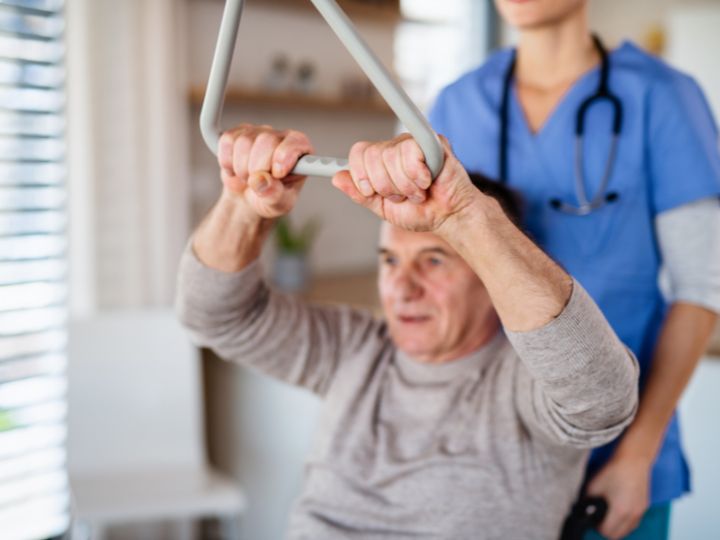For many individuals facing mobility challenges, the journey from wheelchair dependence to walking independently represents more than just physical progress—it symbolizes reclaiming independence, dignity, and quality of life. While this transition can seem daunting, home-based physical therapy has emerged as a powerful approach that brings professional rehabilitation services directly to where patients feel most comfortable: their own homes.
Understanding the Journey
The path from wheelchair to walking is rarely linear. It requires dedication, perseverance, and professional guidance tailored to each individual’s unique circumstances. Whether recovering from surgery, managing a progressive condition, or rehabilitating after an injury, the goal remains consistent: maximizing functional mobility and independence.Common Conditions That May Require Wheelchair-to-Walking Rehabilitation:
- Stroke recovery
- Spinal cord injuries
- Total joint replacements
- Multiple sclerosis
- Parkinson’s disease
- Traumatic injuries
- Post-surgical recovery
- General deconditioning after prolonged hospitalization
The Benefits of Home-Based Physical Therapy
Home-based physical therapy offers distinct advantages over traditional outpatient rehabilitation, particularly for those transitioning from wheelchairs to walking:1. Real-World Environment
When therapy takes place in your own home, you practice navigating the specific environments you encounter daily. Your physical therapist can assess and address challenges unique to your living space, such as stairs, bathroom accessibility, or doorway widths.2. Personalized Attention
Home PT typically provides one-on-one attention for the entire session, without the distractions of a busy outpatient clinic. This focused approach allows therapists to closely monitor technique and make immediate adjustments.3. Reduced Transportation Barriers
For individuals with mobility limitations, simply getting to outpatient appointments can be exhausting and logistically challenging. Home-based therapy eliminates transportation barriers, conserving energy for the rehabilitation process itself.4. Family Integration
Home sessions naturally involve family members and caregivers, who can learn proper assistance techniques and understand how to support the rehabilitation process between therapy visits.5. Comfort and Confidence
Many patients report feeling more comfortable attempting new skills in the privacy of their own homes, where they can progress at their own pace without feeling self-conscious.Key Components of Successful Home PT Programs
1. Comprehensive Assessment
Effective home-based rehabilitation begins with a thorough assessment of:- Current functional mobility
- Home environment
- Available support systems
- Medical history and comorbidities
- Personal goals and lifestyle priorities
2. Progressive Mobility Training
Skilled physical therapists implement a progressive mobility plan that might include:- Bed mobility exercises: Learning to move safely in bed, which forms the foundation for all other mobility.
- Transfer training: Mastering techniques to safely move between surfaces (bed to chair, chair to toilet, etc.).
- Seated balance and core strengthening: Developing the stability needed for standing activities.
- Pre-gait activities: Weight-shifting, standing tolerance, and other preparatory exercises that build toward walking.
- Gait training: Beginning with supportive devices as needed and progressing toward independent walking.
- Stair navigation: Practicing safe techniques for managing steps, a critical skill for home independence.
3. Strength and Flexibility Development
Targeted exercises address the specific muscle groups needed for walking:- Lower extremity strengthening (particularly quadriceps, hamstrings, and glutes)
- Core stability training
- Upper body strengthening for assistive device use
- Stretching routines to improve range of motion
4. Balance Rehabilitation
Balance impairments often contribute to wheelchair dependence. Home PT programs typically include:- Static balance activities (maintaining positions)
- Dynamic balance exercises (maintaining stability while moving)
- Proprioceptive training (awareness of body position)
- Fall prevention strategies
5. Adaptive Equipment Training
Home therapists can recommend and train patients on appropriate assistive devices:- Walkers (standard, rolling, or specialized)
- Canes (standard, quad, or hemiwalkers)
- Leg braces or orthotic devices
- Transfer aids (boards, lifts, or poles)
The Timeline: Setting Realistic Expectations
Every rehabilitation journey is unique, and progress depends on multiple factors including:- The underlying condition
- Overall health status
- Prior functional level
- Cognitive status
- Motivation and participation
- Available support systems
Home Modifications for Successful Transitions
A critical aspect of home-based rehabilitation is modifying the environment to support progressive mobility. Common recommendations include:- Installing grab bars in strategic locations
- Removing throw rugs and clutter
- Rearranging furniture to create clear pathways
- Adding temporary ramps if needed
- Securing loose electrical cords
- Ensuring adequate lighting
- Placing frequently used items within easy reach


